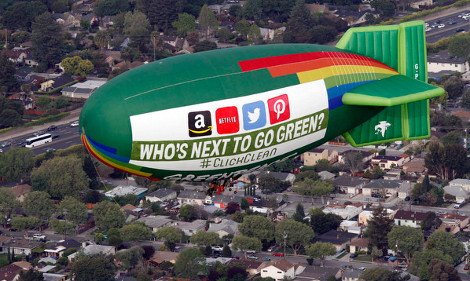In response to the charge by Greenpeace that the company does not make enough effort to use clean energy to power its data centers, Amazon Web Services (AWS) said the environmental advocacy organization based its conclusions on inaccurate data and false assumptions.
“However Greenpeace’s report, Clicking Green,' misses the mark by using false assumptions on AWS operations and inaccurate data on AWS energy consumption,” Amazon representatives wrote in an emailed statement. “We provided this feedback to Greenpeace prior to publishing their report.”
But Greenpeace spokesman David Pomerantz said this was not true. When the organization's researchers showed their energy use figures to Amazon representatives, they said the figures were wrong but refused to provide the correct ones.
The only facility Amazon did offer some specific numbers for was a data center in Ireland. The company said half of the energy powering the facility was renewable and 22% of it came from coal-fueled power plants.
Amazon refused, however, to explain exactly how it had achieved this energy mix for its Ireland data center, Pomerantz said. Without being able to check the figures, Greenpeace went with publicly available data from the Irish national grid, which is what it usually does when it cannot get specific energy use from a company.
In the report on renewable energy use and advocacy by a number of major US-based data center operators, released Wednesday, Greenpeace said Amazon was “among the dirtiest and least transparent companies in the sector, far behind its major competitors, with zero reporting of its energy or environmental footprint to any source or stakeholder.”
The report named Twitter as an offender along similar lines as Amazon.
While shaming Twitter and Amazon, Greenpeace praised Apple and Facebook for being more forthcoming about the energy their data centers use. Both companies have become more transparent and active in procuring renewable energy compared to five years ago, when Greenpeace started its campaign to pursue major data center operators to use their energy buying power to pressure utilities to clean up the fuel mix of the US electrical grid.
The latest report also commended Google for continuing to invest a lot of money into renewable energy development projects in areas close to its data centers and highlighted Facebook's decision to locate a data center in Iowa, which drove “the largest purchase of wind turbines in the world.”
Greenpeace flew its thermal airship over a portion of the rush hour commute on Highway 101 from San Francisco to the Silicon Valley Thursday morning, carrying Apple, Facebook and Google logos on one side and a sign asking “Who's next to go green?” on the other.
Duke Energy, the country's largest utility, recently added the option to buy renewable energy directly for customers in North Carolina. Gary Cook, senior policy analyst at Greenpeace and a chief author of the report, attributed this development directly to the efforts of Apple, Facebook and Google, all three of which have build massive data centers in the state.
“You have three big operators with renewable energy commitments,” Cook said. “Duke has made a point of trying to recruit them.”
In its comments on the report, Amazon said it was working with utilities on renewable options. Pomerantz said that was “exciting to hear” but unfortunately, details on the world's largest public cloud service provider's efforts in that regard were unavailable.
“We'd love to hear how Amazon's doing that, where, and with which power providers – those are the kinds of details that Apple, Facebook and Google have provided publicly which have allowed them to earn high praise, from Greenpeace and many others,” Pomerantz said. “Unfortunately, Amazon has yet to do the same.”
Amazon also pointed out that its data centers in Oregon, one that served typical AWS traffic and one built specifically to serve government agencies, both used “100% carbon-free power.”
Pomerantz acknowledged that Amazon was getting power from hydroelectric plants in Oregon, which is carbon-free. It has been growing so fast there, however, that its power provider, Umatilla Electric Cooperative has been lobbying the state to ease utility renewable energy portfolio requirements there, he added.
“If Amazon were acting responsibly, it would partner with its utility to bring more wind and solar to its energy grid, not less.”
We have asked Amazon to provide more details about the points it made in its official statement about Greenpeace's report but have not received a response.

